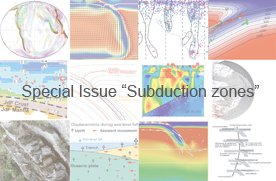Tomography of the 2011 Iwaki earthquake (M 7.0) and Fukushima nuclear power plant area
Abstract. High-resolution tomographic images of the crust and upper mantle in and around the area of the 2011 Iwaki earthquake (M 7.0) and the Fukushima nuclear power plant are determined by inverting a large number of high-quality arrival times with both the finite-frequency and ray tomography methods. The Iwaki earthquake and its aftershocks mainly occurred in a boundary zone with strong variations in seismic velocity and Poisson's ratio. Prominent low-velocity and high Poisson's ratio zones are revealed under the Iwaki source area and the Fukushima nuclear power plant, which may reflect fluids released from the dehydration of the subducting Pacific slab under Northeast Japan. The 2011 Tohoku-oki earthquake (Mw 9.0) caused static stress transfer in the overriding Okhotsk plate, resulting in the seismicity in the Iwaki source area that significantly increased immediately following the Tohoku-oki mainshock. Our results suggest that the Iwaki earthquake was triggered by the ascending fluids from the Pacific slab dehydration and the stress variation induced by the Tohoku-oki mainshock. The similar structures under the Iwaki source area and the Fukushima nuclear power plant suggest that the security of the nuclear power plant site should be strengthened to withstand potential large earthquakes in the future.






